There is often some confusion about the differences between an electric bike and a regular bike.
At first glance, they look very similar to each other but, upon closer inspection, you can start to see how the technology on the e-bike is just as different as it is similar to a regular bike.
To put it simply, an electric bike is a regular bike with an added drive system. The drive system consists of a motor, battery, and a way to steer the motor’s power into the drivetrain. Although the cost of an electric bike is similar to a regular bike, maintenance on an electric bike is often more expensive. However, the speed of a traditional bike is usually a lot lower for typical users.
Let’s take a closer look at the attributes that truly set the two bikes apart, including speed, rules and regulations, riding experience, appearance, and maintenance.
First, let’s look at the history of the traditional bike and its electric counterpart.
Over 200 Years of Bicycle History
Overview
In 2017 the bicycle celebrated it’s 200 birthday. The bikes’ impact on our culture and tradition is unprecedented because it created mobility where there previously wasn’t.
Although the automobile took a significant portion of the traditional bikes market share, it wasn’t until the e-bike that the regular bike saw a substantial cut in its profits.
With over one billion bicycles in the world, the traditional bike is the most common mode of transport worldwide by a large margin. The passenger car looks meager in comparison to only 500 million.
Looking at Germany, there are over 81 million bikes and only 45 million cars, with 3 million of those bikes consisting of electric bikes, scooters, or other electric assisted vehicles.
It’s easy to see why bikes have gained popularity in part of its mobility and economical design. The bicycle quickly replaced stagecoaches and turned nobility on its head.
No longer were the bourgeoisies the only class that could comfortably ride long distances. It’s likely that without the traditional bike, automobiles wouldn’t exist in their current form.
The Invention of the Traditional Bicycle
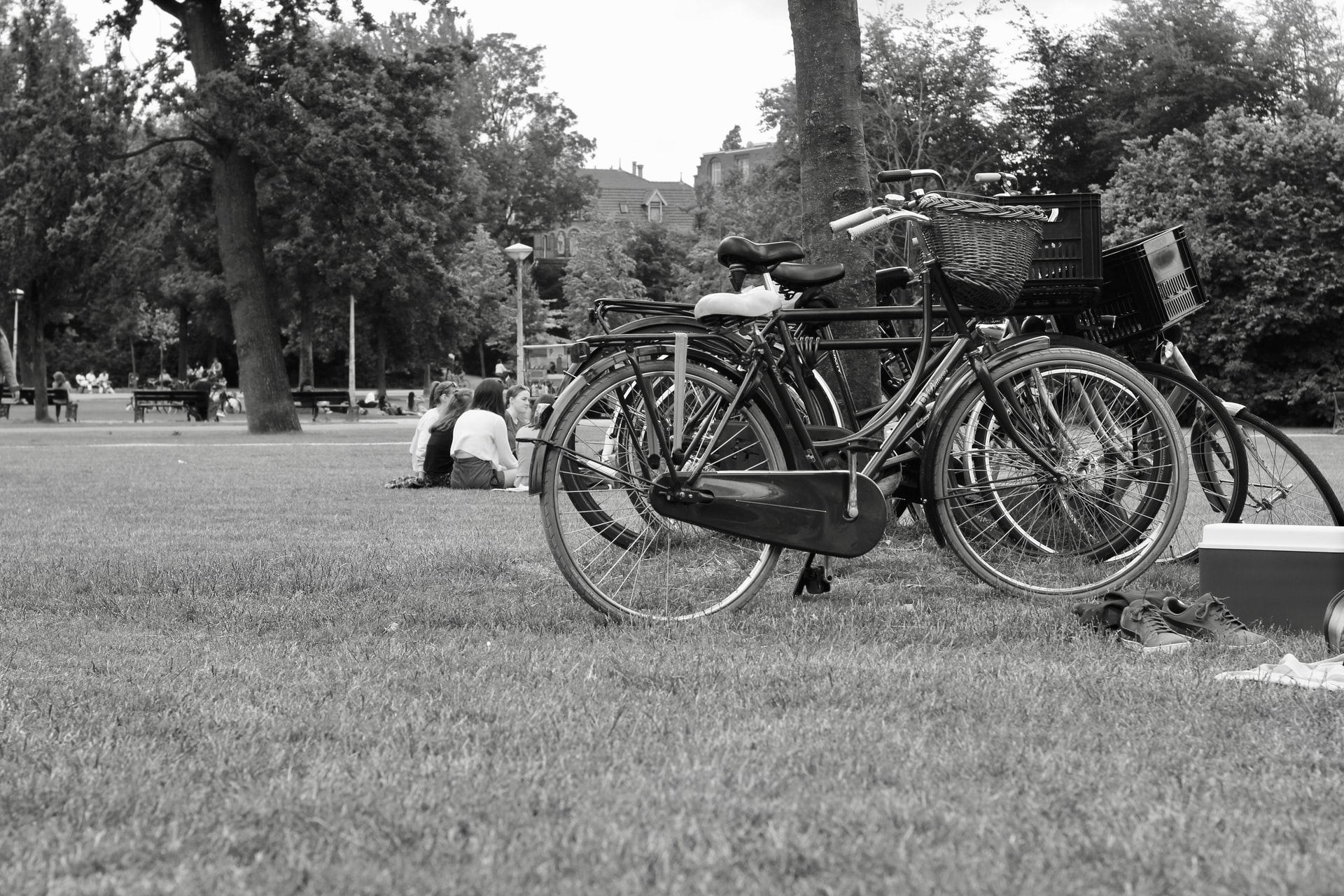
Photo Courtesy: Louis Hansel @shotsoflouis/Unsplash
The first bike prototype was called the running machine or dandy horse created in 1817 by Karl Drais. It had no pedals and could only propel with kicking the road beneath it. In 1860, the crankset and pedals were mounted on the dandy horse by Pierre Michaux. The first bicycle prototype, created by John Kemp, was built in 1885.
Visionary Robert Bosch and the Bosch group are responsible for many add-on inventions to the modern bicycle. In 1890, Robert Bosch popularized biking in Germany and the rest of Europe by riding a High-Wheeler, which had a large front wheel and a tiny rear wheel for stabilization. In 1903, the hub gear system invented by Erst Sachs was the first mass-produced part.
Back to the Bosch company in 1923, the invention of the dynamo lighting system produced over 20 million units by the 1960s and allowed commuters to bike at night.
The derailleur system, invented by Tullio Campagnolo in 1948, was a style-setting influence for years to come – even during the birth of the mountain bike in 1973.
In the modern area of 1993, Yamaha mass-produced the crank-drive pedelec motor to support and reinforce active pedaling.
Since then, inventions have been focused on e-bikes. Regardless of which bike is featured, Bosch has remained the European market leader in bicycles since 2013.
The Invention of the Electric Bicycle
Electric bikes don’t have as long as history as traditional bikes, but inventors have attempted to make e-bikes roadworthy since 1895, but it wasn’t possible until the modern era.
For one, the heavyweight of the electrically driven wheels coupled with the batteries’ low range made e-bikes useless until the invention of the lithium-ion battery in 1991.
It’s now possible to ride over 62 miles (100 km) on a single charge, and with the mass production of electric bikes, motors, and batteries, the technology is more accessible than it ever has been.
Pedelecs are actively shaping city landscapes and making us rethink how to use and maintain proper cities and transportation.
Technical Differences Between an E-Bike and Regular Bike
Electric bikes have electrical components, whereas a regular bike has mechanical components. They both work in similar ways, except the electric bike has the additional drive system, which consists of a motor, battery, a way to control the power, and a way to integrate said motor’s power into the drive train.
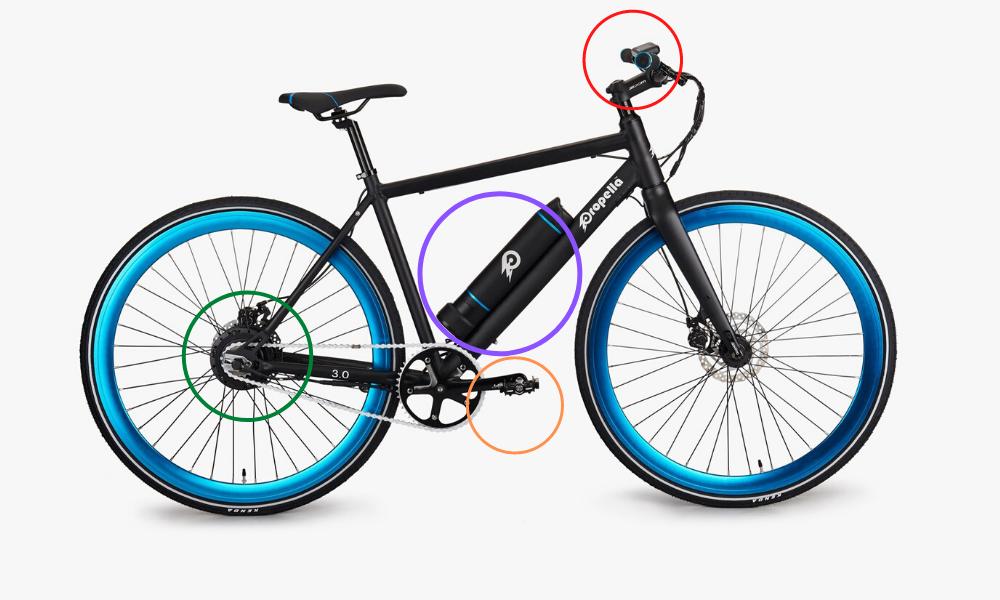
Photo Courtesy: Katrina Dent/Propella
Take a look at the Propella e-bike. It looks similar to a traditional bike, but the color circles indicate the electrical differences. The red circle highlights the throttle, the orange circle shows the mid-drive motor, the green circle is the drivetrain, while the purple circle is the battery that powers the motor in the rear.
Mid-Drive Motor
Although some e-bikes use hub-motors, the mid-drive motor was invented to improve on the short-comings of the hub-motor.
For one, mid-drive motors have a more significant gear ratio so that the rider can power the rear wheels with the same chain and gear set. Mid-drive motors are great for riding up steeper hills and are unlikely to overheat.
Weighing only 5 lbs, the mid-drive motor packs a lot of punch and acts as the motor to power the e-bike. Mid-drives allow for true torque sensors for pedal-assist systems (like the Propella) to regulate the motor power based on how hard you push.
Its center of gravity is close to the ground to improve handling while distributing the weight easier throughout the bike.
Battery
The most expensive and heavy component of the bike, the typical electric battery can provide up to 40 miles (64 km) of riding, but multiple factors determine the true scope, range, and power of the battery.
There are 4 common types of batteries on the market: lead-acid, nickel-cadmium, nickel-metal hydride, and lithium-ion.
Lithium-ion batteries are becoming the default battery because they produce more power output and weigh significantly less than the other options.
Most importantly, they’re durable and will last longer. Although this component is costly, it’s more than worth it because it knocks other batteries out of the park when it comes to range, weight, and longevity.
Drivetrain
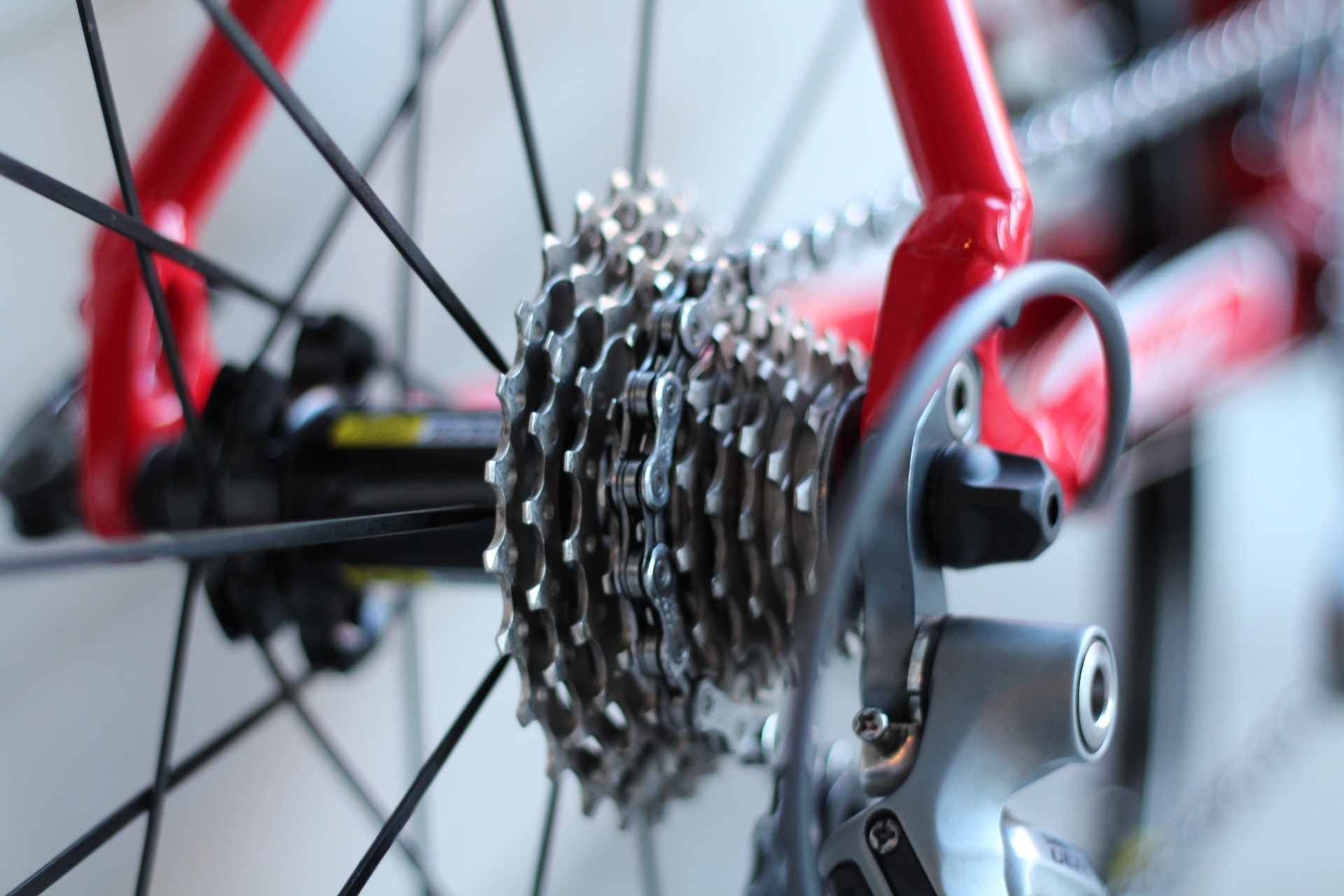
Photo Courtesy: Wayne Bishop/Unsplash
The drivetrain delivers power to the driving wheels and converts torque and speed via the gears. Many e-bikes on the market allow you to ‘turn up the dial’ to adjust the gears on the drivetrain, so you’re able to scale steeper hills.
To protect against accelerated wear on the drivetrain, the power in the motor is typically limited to around 250-500 watts.
A significant drawback of an e-bikes drivetrain is that it has to be charged (though not on a regular basis) while the traditional bicycle drivetrain doesn’t.
An uncharged drivetrain won’t be able to shift gears. As a benefit, the drivetrain, when charged, will remain consistent while switching gears because there are no cables that could slop or stretch over time.
Throttle
Most e-bikes have two modes: throttle mode and pedelec mode. Where the pedelec mode works similar to a traditional e-bike and uses pedals to propel forward, the throttle mode on an electric bike works identical to a motorcycle throttle.
The throttle engages the motor and provides power and moves you and the bike forward.
A throttle component allows e-bike users to sit back and let the bike do all the work. Some e-bikes allow for both the throttle and pedelec modes to engage at the same time.
This will enable commuters to go above the top speed of the bicycle while getting some exercise in the process. Not all countries allow for the throttle feature on bikes.
Except for the above 4 components, all other parts on an e-bike are the same as a traditional bike. E-bikes still have a frame, disc, brakes, two wheels, a seat, suspension, pedals (in most cases), and handlebars.
Electric Bike Display
It’s uncommon to find an electric bike with a display – especially if you’re riding anything under $1000. However, you can always buy an electronic bike display and hook it up to your battery and motor for accurate readings on the range, battery level, speed, distance, and trip distance. Traditional bikes hardly ever come with a display, and it typically isn’t as advanced.
More expensive e-bikes offer additional bike display features, such as tracking sat nav/GPS and fitness tracking. These displays can help you quickly interpret how many calories you’re burning in a session and location, as well as the overall health of your bike.
I recommend you purchase an e-bike with a display to better understand your e-bikes range, max speed, and battery level as it helps with general maintenance.
The Differences in Riding Experience

Photo Courtesy: Javier de la Maza/Unsplash
Although there aren’t many differences between an electric bike and a traditional bike, the riding experience can be vastly different. Whereas an e-bike commuter can choose not to use the throttle and ride it like a conventional, albeit a heavier bike, the traditional bike can only act as an ordinary bicycle and only use the pedals to propel itself.
The major shortcoming of a traditional bike is its accessibility. Maybe you want to be fit, but you’re not quite there yet. Perhaps you want to ride a bike to work to save on gas money, but you’re concerned about arriving to work sweaty.
Or, maybe a heart disease or other physical impairment prevents you from participating in a more active lifestyle.
The electric motor solves these problems. No matter how windy, how long, or how far your commute is, the motor will help you arrive at your destination.
If you want to bike, but halfway to your destination you’re exhausted, you can use the throttle to coast the rest of the way.
Riding a bike gives you the freedom to ride unencumbered by traffic or the size of the road. You also don’t have to worry about the price of gas (just electricity for an e-bike).
Electric bikes add that extra bit of freedom to all because it’s an accessible and fun activity.
Fitness vs. Convenience
Let’s get this out of the way: riding an e-bike, even one that isn’t pedal-assisted, isn’t cheating your health or fitness levels. The automobile was invented to solve the problem of a long-distance commute without the reliance on horses.
E-bikes fill that need for those who can’t afford cars in the big city while also providing a means of accessible transportation.
I’m a cyclist, but if I have to take a 40 mile (64 km) round-trip to a friend’s house or work, I reach for the car keys instead.
If I’m feeling tired, I’m more likely to use the path of least resistance, especially if the road ahead is hilly.
With an electric bike, I can make the same trip with minimal effort if I choose only to use the throttle. I can do errands easier, and quicker, because I don’t have to wait in traffic or find somewhere to park. It also saves me money on gas.
Instead of looking at a traditional bike vs. electric bike and riding vs. not riding, look at it as a fun, convenient, and accessible way to travel. With a pedal-assisted e-bike, I can also get my exercise in if I choose to.
Maintenance and Repairs
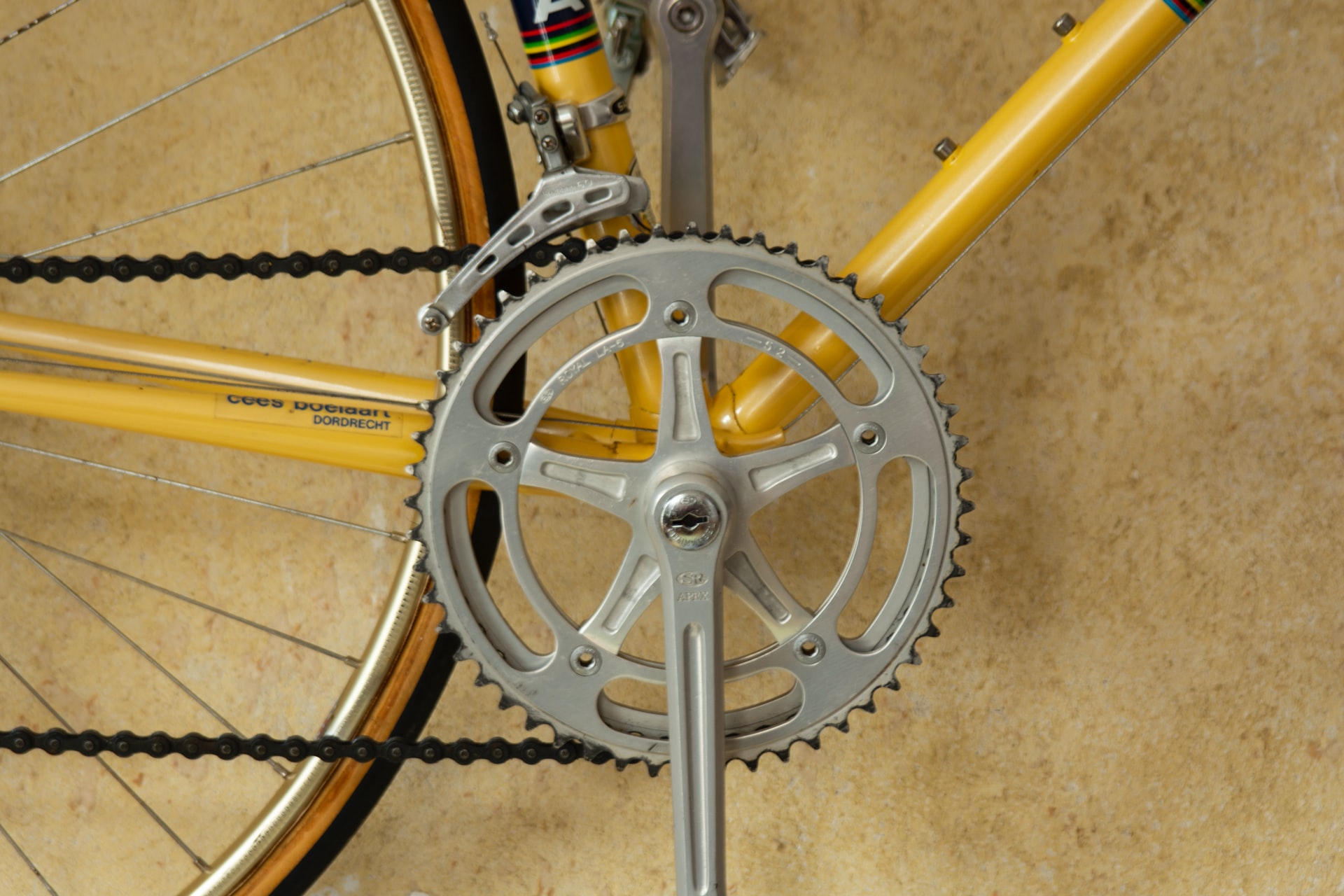
Photo Courtesy: Jeremias Radny/Unsplash
The traditional bike and e-bike require frequent maintenance, but the e-bike could cost more if the battery or motor is damaged. Overall, the cost of maintenance and repairs is similar.
Keep Your Bike Clean
Clean both your bike and e-bike regularly to maintain the look and overall health of your vehicle. Both the traditional bike and e-bike can use diluted dish soap and rags to wipe down the frame gently.
Try not to use soap or water on gears or other components that could rust, or they may erode and require a replacement.
While cleaning an e-bike, you will need to be more careful, or you risk damaging or destroying the electrical components. Always take the battery out, and clean carefully around the motor, battery container, and drivetrain.
Both the traditional bike and e-bike can be polished with a bicycle wax to add an extra layer of protection over the frame and paint.
Lubrication
To keep all gears in good working order, apply lubrication to the moving parts such as the chain and brake. Use a special cleaning solution to wipe off dirt or mud on these components before applying lubricant.
Both the traditional bike and e-bike need lubrication in the same locations once a week.
Inflate Tires
Both the traditional bike and e-bike need properly inflated tires at all times. It’s important to check tire pressure at least once a week and check tires for uneven wear or puncture holes.
E-bikes can come with airless tires, so tire pressure won’t be an issue in this case. However, it is still essential to check for wear on airless tires.
Check Brakes
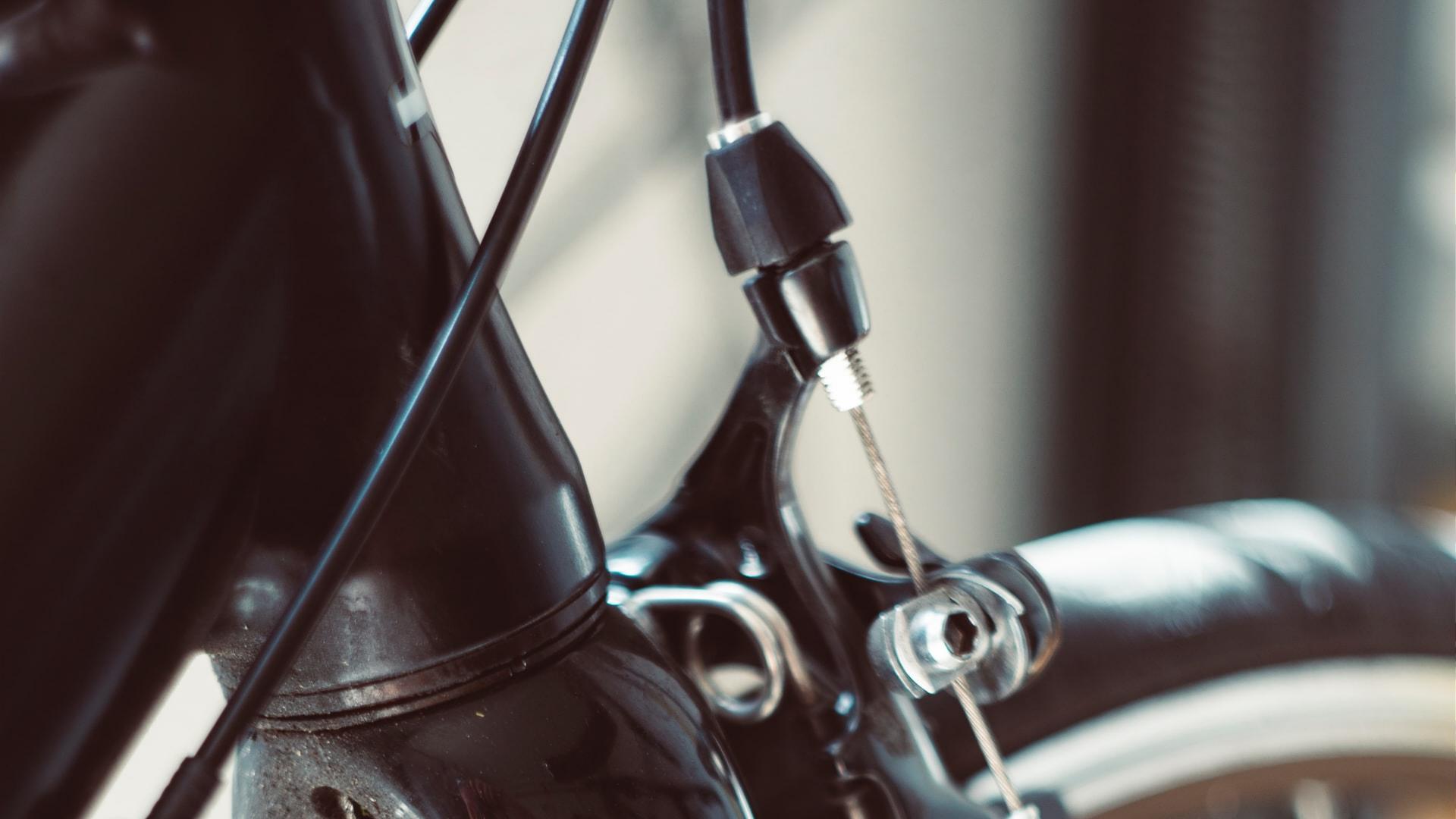
Photo Courtesy: Markus Spiske/Unsplash
On a traditional bike, the brakes are connected through a series of cables. Instead, an e-bike uses brake pads similar to an automobile to stop quicker at fast speeds.
For brake cables, check if there are any tears and that the connection isn’t loose or severed. For brake pads, check for wear and tear, and that the nubs on the pads aren’t too worn down.
To test either kind of brakes, ride at less than 8 miles (12 km/h) and pump the brakes. Notice how fast you stop and if you need to adjust the brakes stopping power.
It’s always better to test your brakes before riding (especially on an e-bike) to prevent potential accidents.
Tighten Nuts and Bolts
Every week, check all the nuts and bolts on your bike and tighten any that look loose. To quickly determine which nuts and bolts require tightening, use your fingers to try and loosen screws.
If they come apart easily, they are too loose and need a wrench to tighten them. Never use your fingers to tighten nuts, bolts, or screws because they won’t stay that way long-term.
Battery and Motor
Unique to the e-bike is maintenance on the battery and motor. Always read the manufacturer’s instructions to properly preserve both parts long-term.
Since battery and motor replacements are expensive, ensure that water, dirt, or dust doesn’t get inside its components. Always remove both parts during storage or in colder temperatures.
Average Speed

Photo Courtesy: Anthony Gilbert/Unsplash
As of writing this, the world record bicycle speed is 183.9 mph (295 km/h) broken by Denise Mueller-Korenek, 45, and with a draft provided by a dragster.
The average cycler doesn’t achieve speeds close to that at 9.6 mph (15.5 km/h) on a flat surface. A fit rider can maintain speeds of 25 mph (40 km/h), which is also the average speed of a moderately priced e-bike.
An e-bike, unless it’s rigged to do so, doesn’t exceed speeds of 40 mph (64 km/h) with a throttle. In the United States, an e-bike cannot exceed speeds of 28 mph (45 km/h) legally either on the sidewalk or street.
Although it is possible for a human-powered bicycle to exceed 28 mph and 40 mph, you cannot do so unless you’re exceptionally fit.
If you’re not racing, e-bikes might make your ride faster (and arrive at your destination less sweaty).
This is because the e-bike’s motor makes pedaling feel effortless so you won’t get tired as quickly. An e-bike also helps to maintain a constant speed.
Rules and Regulations
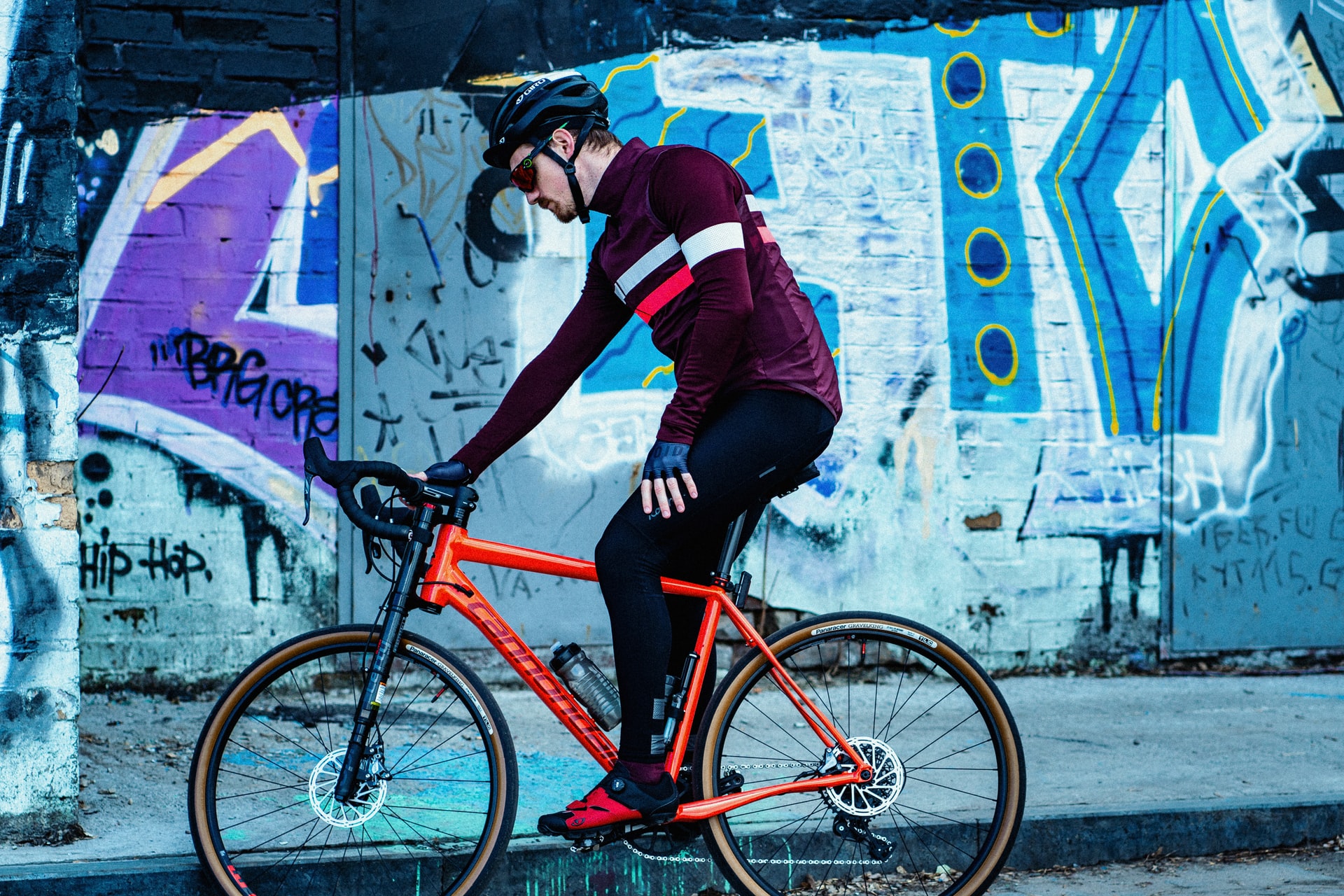
Photo Courtesy: Victor Xok/Unplash
Although there are rules and regulations for a traditional bike, these rules don’t carry the same weight if you break them compared to e-bikes.
Traditional Bike
In the US, all bicycles must have lights between sunset and sunrise to improve visibility and reflectors so other vehicles can see you. Brakes are also mandatory, but only one functioning brake is necessary for US bylaw.
The requirement to wear a helmet in the US varies based on jurisdiction and age, but it’s usually a good idea to wear on if you’re riding in traffic.
As a general rule in the United States, all bikes must ride on the right-hand side of the road and never against the traffic flow. You must occupy the same space as motor vehicles and never on the sidewalk unless there is a designated bike lane.
Since a bicycle is considered a slow-moving vehicle, you must position yourself as far right as possible so cars can pass you.
Hand signals are required to inform cars where you plan on turning. As an alternative, you can buy electronic signals or brake lights.
Breakings any of these rules usually results in a slap on the wrist (at most a ticket) unless you cause a significant accident.
E-Bike Regulations
E-bike regulations include bicycle bylaws but start to become more complicated depending on where you live. In most states, e-bikes are considered either motorcycles or slow-moving electric vehicles.
Some states, like California, have their own classification for e-bikes. As of writing this, there is only one US state that requires an e-bike license for operation (while other states either don’t require one or only accept another license like an M or Class 3).
Many states are looking to implement the 3 class system, which puts different e-bikes in 3 different classifications. Creating appropriate e-bike laws is a slow-moving process, but most states are starting to implement this system.
Since all e-bike regulations pass at a state level, the rules vary depending on where you live.
The minimum age of riding and the necessity for helmets is another contested topic. While some states require a minimum age between 14-18 to operate an electric bike, others have no minimum or distinction between class 3 bikes (any e-bike that can travel 28 mph (45 km/h).
Although helmets aren’t necessary to wear in all states, I recommend you wear one anyway!
Overall, e-bike laws are confusing in the United States, but are more straightforward in Europe and Canada as the requirements are consistent throughout their states and provinces.
Always check your state laws before operating an e-bike.
Are you an e-bike or bicycle enthusiast? What to read more about e-bikes and e-scooter? Stay on our website for more in-depth articles on electric transport.
Before you go, leave a comment on what you think about the differences between traditional bikes and e-bikes, or read one of our other articles about the top speed for an e-bike.


